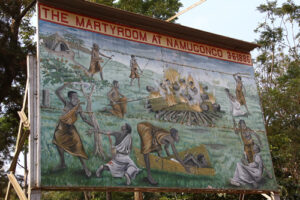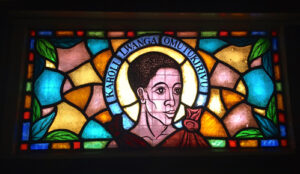The Munyonyo Martyrs shrine which is also known as the Uganda Martyrs parish was created by Archbishop Dr. Cyprian Kizito Lwanga in 2016. It was created in honor of Pope Francis’s visit to the shrine in November 2015. Located about 13 kilometers away from the Kampala city center in a 6 acre piece of land along Salaama road, the history of this Martyrs shrine relates back to the time when Christianity was first introduced in the Buganda kingdom.
 In 1885, a group of 22 young Roman Catholic Christian men were killed on the orders of King (Kabaka) Mwanga after they had refused to abandon their faith in Christianity. Kabaka Mwanga’s father Muteesa had welcomed the Christian missionaries with an open arm. When Mwanga took over, he saw Christianity as a threat and something that would lead to the collapse of his rule and kingdom. He did all he could to stop it’s spread including deciding to kill the Uganda Martyrs. You can read more about the Uganda Martyrs Day Celebrations in Namugongo.
In 1885, a group of 22 young Roman Catholic Christian men were killed on the orders of King (Kabaka) Mwanga after they had refused to abandon their faith in Christianity. Kabaka Mwanga’s father Muteesa had welcomed the Christian missionaries with an open arm. When Mwanga took over, he saw Christianity as a threat and something that would lead to the collapse of his rule and kingdom. He did all he could to stop it’s spread including deciding to kill the Uganda Martyrs. You can read more about the Uganda Martyrs Day Celebrations in Namugongo.
Background to the Construction of the Martyrs Shrine in Munyonyo
12 Roman Catholic Martyrs were burnt to death at Namugongo while 9 were killed in different places along the journey from Munyonyo. Among those killed along the journey were Andrew Kaggwa and Denis Ssebugwawo who were both executed at Munyonyo, not far from the Kabaka’s Munyonyo palace. Pontian Ngondwe was also killed at a place called Takkajjunge near Munyonyo. The three Martyrs inspired the construction of the Munyonyo Martyrs shrine.
 Before the construction of the Martyrs shrine in Munyonyo, churches and chapels were set up in the respective spots where the martyrs were killed on their way to Namugongo. During his visit to Uganda in 2015, Pope Francis made a pilgrimage to the Munyonyo martyrs shrine before he went to the main Shrine in Namugongo where he celebrated mass. A year later, the Martyrs Shrine in Munyonyo was made a full Catholic parish and under the jurisdiction of the Kampala Archdiocese. The Munyonyo shrine also made history as the very first sub-parish to be visited by the Pope, thanks to the great efforts put in by Archbishop Cyprian Kizito Lwanga and other clergy.
Before the construction of the Martyrs shrine in Munyonyo, churches and chapels were set up in the respective spots where the martyrs were killed on their way to Namugongo. During his visit to Uganda in 2015, Pope Francis made a pilgrimage to the Munyonyo martyrs shrine before he went to the main Shrine in Namugongo where he celebrated mass. A year later, the Martyrs Shrine in Munyonyo was made a full Catholic parish and under the jurisdiction of the Kampala Archdiocese. The Munyonyo shrine also made history as the very first sub-parish to be visited by the Pope, thanks to the great efforts put in by Archbishop Cyprian Kizito Lwanga and other clergy.
In 2017, the Munyonyo Martyrs shrine was consecrated by Cardinal Fernando Filoni during his pastoral visit to Uganda. This preceded the elevation of the Munyonyo martyrs shrine as a mini basilica on July 2019. It should be remembered that the Catholic Martyrs Shrine in Namugongo was also elevated to a mini basilica after the visit of Pope John Paul II in the year of 1993. The two Martyrs shrines were elevated to the level of being basilicas because of their architectural worth and historical importance in addition to their significance as places of worship. This implies that they have special privileges from Rome.
Details about the Munyonyo Martyrs Shrine
The mini basilica in Munyonyo has a sitting capacity of 1,600 and was constructed in only 16 months. The official opening ceremony took place in May 2015. The state of the art mini basilica construction was funded by the local people and some well-wishes who contributed generously towards the project. One of the well-wishers who funded this major construction was the Grodko parish of south east Poland who supported the construction by donating a tabernacle which was worth 33 million shillings.
The Architect behind the magnificent Munyonyo Martyrs basilica was Mr. Robert Sserembe. There are specific distinctive architectural details that have made the basilica unique and these include the 12 pillars upon which the basilica stands. These twelve pillars represent the twelve disciples of Jesus Christ. There is also the unique 45-meter aluminum cross standing tall on the rooftop which is currently the tallest of its kind in Uganda. The interior of the basilica is very beautiful with a ceiling made out of Mahogany with 189 shining lights prominently in the ceiling. The Munyonyo basilica is a holy environment and very beautiful place to go to if one wants to reflect upon their spiritual life. It is also an important tourism site in Uganda where you can be taken on a guided walk around the 6 acre premises of the shrine. There are several other plans underway to develop the basilica further. Upon the successful completion of the plans, the basilica will be a major religious tourism center.

